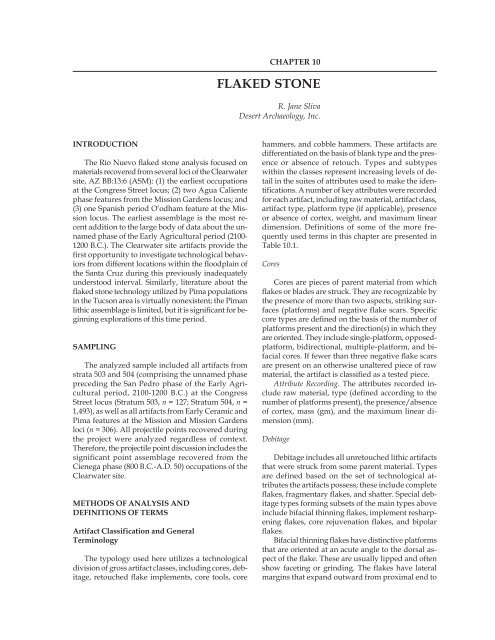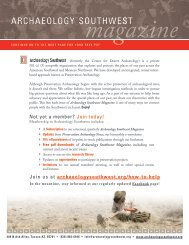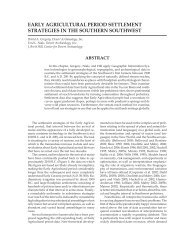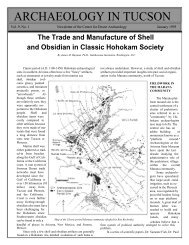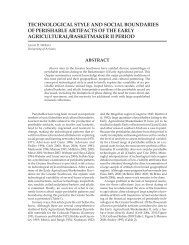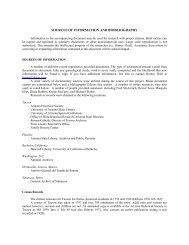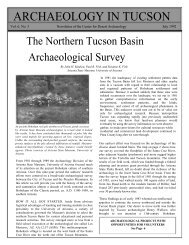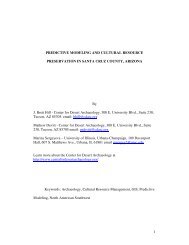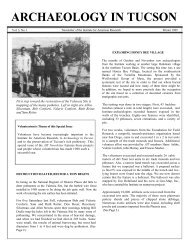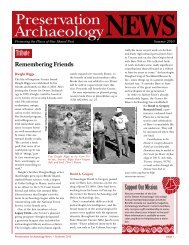Chapter 10 â Flaked Stone - Archaeology Southwest
Chapter 10 â Flaked Stone - Archaeology Southwest
Chapter 10 â Flaked Stone - Archaeology Southwest
You also want an ePaper? Increase the reach of your titles
YUMPU automatically turns print PDFs into web optimized ePapers that Google loves.
Expanding Nursing'sInfluence in 21st CenturyHealth CareTitle text hereBrenda L. Cleary, PhD, RN, FAANDirector, Center to Champion Nursing in America
<strong>10</strong>.2 <strong>Chapter</strong> <strong>10</strong>Table <strong>10</strong>.1. General terminology for Desert <strong>Archaeology</strong>, Inc., flaked stone analysis.TermRetouchUtilization damage/Edge damage/Use-wear/Wear tracesImplementRetouched implement/Flake toolUtilized flakeFormal tool/Formallyretouched implementExpedient tool/Expedientlyretouched implementCore toolDefinitionIntentional, macroscopically visible modification to the edge of a piece of lithicmaterial, generally in the form of flaking; the conventional requirement for classifyingedge modification as retouch is the presence of three or more contiguous intentionalflake removals along a common edge.Macro- or microscopically visible modification of the edge of a piece of lithic materialas a result of utilization or postdepositional processes; it is an unintentional by-productof behavior rather than an intended effect. Given this and the definition used forretouch, the term "use retouch" is misleading and is avoided here.A piece of stone that was either utilized or designed to be utilized to perform a task.Flake with one or more retouched edges, regardless of the presence or absence of weartraces.An unretouched flake that has been used to perform a task; identified by the presenceof wear traces.Implement with patterned retouch corresponding with one of the traditionallyestablished, intuitive tool types (e.g., projectile point, drill, biface, notch, graver,perforator, endscraper, sidescraper).Retouched implement characterized by unpatterned, usually nonextensive retouch;these may also be referred to as informal tools.Core with one or more retouched edges; flake implements are made from the byproductsof core reduction, while core tools are made by shaping original cobbles ortablets of raw material into implements through flaking.termination, giving them a semitriangular shape, andhave incurved bulbar aspects that result in a distinctiveappearance in cross section. Desert <strong>Archaeology</strong>analyses include both specifically identified bifacialthinning flakes (BTF) and potential retouch flakes(PRF), which include all complete flakes whose metricattributes fall within the range of variation observedfor the BTF from a given region and time period.Implement resharpening flakes are recognizableby a use bevel or other wear traces along the lengthof their platform edges; they are struck from a dullededge to provide a fresh, sharp edge for continuedwork.Core rejuvenation flakes are struck from cores toremove exhausted platforms and extend the use-lifeof the core. These are generally recognizable fromthe flaking platforms and partial flake scars aroundtheir perimeters, or by a ridge formed by remnantplatforms across the dorsal aspect of the flake.Another special debitage type that warrants aseparate discussion is the utilized flake, which is anon-retouched flake with edge damage (abrasion,flaking, crushing, striations) and/or polish indicatingit has been used to perform some task. While utilizedflakes are subsumed by the debitage artifactclass (due to the absence of retouch), they are usuallyincluded with retouched flake tools in discussionsof task-related behaviors at a site.Attribute Recording. Debitage was coded individually;recorded attributes included raw material, completeness,portion (if incomplete), presence/absenceof cortex, platform type, termination type, type ofplatform preparation (grinding and/or faceting),number of remnant flake scars on the dorsal aspect,mass (gm), and a measure of linear dimension (mm).Desert <strong>Archaeology</strong> analyses rely on a single measurementof a flake’s maximum linear dimension(irrespective of the flaking axis); dividing flake massby this number results in a mass index value used toexpress relative flake thickness (lower values resultfrom a lower weight-to-linear size ratio, indicatingthin flakes).Potential Retouch Flakes. The metric attributes recordedfor debitage are used to discriminate subsetsof artifacts representing various technological behaviors.In this analysis, the distribution of size andweight data for identified bifacial thinning flakes wasused to set the size thresholds for potential retouchflakes in the assemblage. The maximum mass indexfor likely retouch flakes was obtained from the meanvalue across all identified BTF in the Desert <strong>Archaeology</strong>database, plus 1 sigma (0.076). This mass indexthreshold covers 91 percent of the BTF, whichis a tolerable level of accuracy in filtering the overalldebitage assemblage. Therefore, discussions ofpotential retouch flakes in this report refer to the
<strong>Flaked</strong> <strong>Stone</strong> <strong>10</strong>.3proportion of complete flakes in the assemblage thatdo not exceed this mass index threshold.UnifacesUnifaces are flakes with retouch extending froman edge onto only one aspect of the implement. Notethat an implement with retouch on both aspects isstill classified as a uniface as long as the sets of retouchflakes do not originate from a common edge.Attribute Recording. The attributes recorded forunifaces include raw material, cortical coverage, mass(gm), and maximum linear dimension (mm). Whentime allows, the location, shape, and length of theretouched edge is recorded; otherwise, the retouchattributes exhibited by a particular artifact are summarizedwith reference to an established type name.Retouch is described with reference to dichotomousqualitative attributes and the angle of the resultingmodified edge (Table <strong>10</strong>.2; after Rozen 1984:457-459). Attributes are assigned through a series ofyes-no questions (e.g., is the retouch extensive? is theretouch invasive?) to create a set of attributes correspondingto a technological type.BifacesAlthough it is sometimes impossible to determineif a biface was made on a flake/blade blank or a coreblank, in the current system, bifaces are consideredto be flake tools with retouch extending onto bothaspects of the blank from a common margin.Common bifacial types include general bifaces,drills, and projectile points. General bifaces lack designedspecial-function components such as elongatedbits or hafting elements and are classified accordingto stage of manufacture (Table <strong>10</strong>.3). Drills have pronouncedbits that are usually thick and diamondshapedor square in cross section. Most drills aredesigned with some provision for hafting, such as anarrow, pointed base that fits into a socket in awooden shaft, or flanges or notched bases allowingthe drill to be secured to a shaft with sinews or otherwrapping material. Projectile points have a sharpTable <strong>10</strong>.2. Definitions of retouch attributes.Retouch TypeUnifacialBifacialIrregularContinuousMarginalInvasiveNonextensiveExtensiveDefinitionRetouch scars that extend onto only one aspect, or face, of the implement.Retouch scars that extend from a common margin onto both aspects of the implement.Two or more noncontiguous retouch scars, but not more than two contiguous scars.At least three contiguous retouch scars.Retouch scars whose lengths do not exceed <strong>10</strong> percent of the maximum dimension of the implement.Retouch scars whose lengths exceed <strong>10</strong> percent of the maximum dimension of the implement.Continuous retouch scars whose extent is less than 20 percent of the perimeter of the implement.Continuous retouch scars whose extent is greater than 20 percent of the perimeter of the implement.Table <strong>10</strong>.3. Stages of biface manufacture (from Anderson and McDonald 1986:7.48-7.52).Stage Characteristics1 Thick cross sections; markedly sinuous edges; hinge and step fractures; and deep, broad flake scars; corticalsurfaces and stacked step fractures common.2 Significantly lower length, width, and thickness than Stage 1 bifaces; irregular but straighter edges, irregularbut more shallow flake scars, and far fewer hinge and step fractures, likely due to a shift by the knapperfrom a hammerstone to an antler billet; cortex expected to occur at a rate of roughly 30 percent.3 Slightly sinuous edges, infrequent hinge and step fractures, and more regular, diffuse, and less expandingflake scars; approximately 30 percent thinner than Stage 2 bifaces; manufacture-induced breakage common;essentially finished implements lacking pressure flaking, final thinning, and hafting elements.4 Regular outlines, straight edges, and regular flake scars; pressure finishing common; cortex completelyabsent; tend to be significantly shorter than Stage 2 bifaces and 30 percent thinner.
<strong>10</strong>.4 <strong>Chapter</strong> <strong>10</strong>point at one end and a hafting element at the other.Point classification systems are regionally specific,with types defined according to sets of morphologicalattributes, such as notch location, stem shape,blade shape, length-to-width ratio, and flaking technique.Some types incorporate subregional or phasebasedvariants.From a technological view, it is informative toaddress general bifaces in terms of the stages ofmanufacture, and thus, the level of labor investmentthey represent. The classification system used herefor bifaces replicates that developed by Anderson andMcDonald (1986) for the Wupatki ArcheologicalInventory Survey project. The latter was based onWomack’s (1977) technological analysis and experimentation,which determined that thickness-to-widthratios and flake scar patterns are the variables mostrelevant for discerning biface reduction strategies.The resultant general biface types, produced in fourstages of manufacture, are defined as follows (fromAnderson and McDonald 1986:7.48-7.52).Stage 1 bifaces have thick cross sections, markedlysinuous edges, hinge and step fractures, anddeep, broad flake scars. Cortical surfaces and stackedstep fractures are common. Stage 2 bifaces have significantlylower length, width, and thickness thanStage 1 bifaces. They are characterized by irregularbut straighter edges, irregular but more shallow flakescars, and far fewer hinge and step fractures, likelydue to a shift by the knapper from a hammerstone toan antler billet. Cortex is expected to occur on thesebifaces at a rate of roughly 30 percent. Stage 3 bifaceshave slightly sinuous edges, infrequent hingeand step fractures, and more regular, diffuse, and lessexpanding flake scars. These are approximately 30percent thinner than Stage 2 bifaces, and manufactureinducedbreakage is common. These are basicallyfinished implements, but without pressure flaking,final thinning, and hafting elements. Stage 4 bifaceshave regular outlines, straight edges, and regularflake scars; pressure finishing is common and cortexis completely absent. These tend to be significantlyshorter than Stage 2 bifaces and 30 percent thinner.Attribute Recording. The minimum set of recordedattributes includes raw material, cortical coverage,mass (gm), and maximum linear dimension (mm)measured relative to the long axis of the artifact.When time allows, more complete metric measurementsare taken, although these vary according tobiface type. All other measurements are taken parallelor perpendicular to this line.Projectile point measurements include totallength (mm) and the lengths, widths, and thicknesses(mm) of the blade and stem. Other measurements thatcan be useful for distinguishing differing point typesinclude neck width, basal concavity depth, notch depthand width, and tang angle. Ratios among sets of theseattributes are used to quantify the morphology of agiven point and place it within a range of observedvariation corresponding to a particular type.Core ToolsCore tools are distinguished from retouched flakeimplements by blank type; flake implements aremade on the by-products of core reduction, whilecore tools are produced by shaping original cobblesor tablets of raw material into implements throughflaking. Core tools are generally larger and heavierthan flake tools, but their edge morphologies areanalogous. In the interest of comparative studies, itis preferable to deal with cores, core tools, core hammers,and cobble hammers separately, providingother researchers the opportunity to group or separatethem as they wish.Core tools include scrapers, choppers, discoids,denticulates, and composite tools. Other, more rarelyencountered examples include perforators andnotches. The classification process is essentially thesame as for retouched flake implements, although asmaller set of tool types is defined than for flake tools.Attribute Recording. Recorded attributes includeraw material, cortical coverage, mass (gm), and maximumlinear dimension (mm). As with flake tools,retouch location, type, and angle are summarizedwith reference to an established type name.Core HammersA core hammer is a core with evidence of secondaryuse as a hammer (battering). Core hammersare treated separately from core tools, because eventhough they were utilized as something other than asource for flakes, they were generally not speciallyshaped for the second function. These and cobblehammers are the only flaked stone artifacts definedexplicitly in terms of their inferred function.Due to the specific nature of the type definition,the only types defined for this artifact class are completecore hammers and fragmentary core hammers.Attribute Recording. Raw material, the presence/absence of cortex, mass (gm), and maximum lineardimension (mm) are recorded.Cobble HammersA cobble hammer, or hammerstone, is an otherwiseunmodified cobble that exhibits battering in oneor more locations. Due to the specific nature of thetype definition, complete hammerstones and fragmentaryhammerstones are the only types definedfor this artifact class.
<strong>Flaked</strong> <strong>Stone</strong> <strong>10</strong>.7Table <strong>10</strong>.5. Pre-San Pedro phase raw material distributions, by context, at the Congress Street locus, the Clearwater site,AZ BB:13:6 (ASM).Pithouse/PossiblePithouseExtramural PitNonfeature,Extramural SpaceAll ContextsMaterialTotalPercentwithinContext TotalPercentwithinContext TotalPercentwithinContext Total PercentUnspecified fine-grained igneous 27 8 7 9 230 19 264 17Unspecified medium-grained igneous 33 <strong>10</strong> 4 5 87 7 124 8Unspecified coarse-grained igneous 0 0 0 0 16 1 16 1Basalt or basaltic andesite 70 21 13 18 147 12 230 14Fine-grained dacite, lavender to white 41 12 3 4 40 3 84 5Rhyolite 62 18 31 42 224 19 317 20Fine-grained ashy gray rhyolite or 13 17 61 91andesite/black and white phenocrystsFine-grained gray rhyolite/black 6 0 12 18and white phenocrystsFine-grained black rhyolite/black 2 1 <strong>10</strong> 13and white phenocrystsFine-grained Rillito Peak rhyolite 6 0 26 32("Rillito Peak jasper")Fine-grained dark brown7 4 36 47rhyolite/white phenocrystsFine-grained brown rhyolite/black 1 2 <strong>10</strong> 13and white phenocrystsFine-grained red rhyolite/white3 0 1 4phenocrystsFine-grained red rhyolite/black1 0 1 2and white phenocrystsFine-grained purple rhyolite/white 0 0 1 1phenocrystsMedium-grained gray rhyolite/4 1 20 25white phenocrystsMedium-grained gray rhyolite/3 1 <strong>10</strong> 14black and white phenocrystsMedium-grained light brown<strong>10</strong> 1 25 36rhyolite/white phenocrystsMedium-grained brown rhyolite/ 3 4 5 12black and white phenocrystsMedium-grained pink-gray1 0 2 3rhyolite/white phenocrystsMedium-grained purple rhyolite/ 1 0 2 3white phenocrystsCoarse-grained Rillito Peak rhyolite 0 0 2 2("Rillito Peak jasper")Coarse-grained brown rhyolite/1 0 0 1white phenochrystsObsidian 1
<strong>Flaked</strong> <strong>Stone</strong> <strong>10</strong>.9Table <strong>10</strong>.6. Projectile points and other retouched artifacts from pre-San Pedro (Stratum 504) contexts at the CongressStreet locus, the Clearwater site, AZ BB:13:6 (ASM).ContextFieldNumber Artifact Type FigureNonfeature, extramural space 7173 Cortaro point base <strong>10</strong>.1bNonfeature, extramural space 7194 Non-diagnostic Archaic point fragment; distal half <strong>10</strong>.1gof blade with long impact fractureNonfeature, extramural space 7195 Non-diagnostic point tip fragment <strong>10</strong>.1hNonfeature, extramural space 7289 Non-diagnostic point tip fragment N/ANonfeature, extramural space 7306 Basal quarter fragment, possibly of Cortaro point N/ANonfeature, extramural space 7469 Non-diagnostic point tip fragment with impact N/AfractureExtramural pit Feature 624, fill 7650 Possible San Pedro point blade midsection <strong>10</strong>.1fPithouse Feature 3371, floor fill 9279 Non-diagnostic point tip fragment <strong>10</strong>.1iPithouse Feature 3371, floor 9299 Cortaro point basal fragment with impact fracture <strong>10</strong>.1aPithouse Feature 3359, floor fill 9204 Cortaro point with an impact fracture and possible <strong>10</strong>.1csecondary use as drillPithouse Feature 3359, floor fill 9234 Complete Stage 1 biface N/ANonfeature, extramural space 7142 Large flake perforator N/ANonfeature, extramural space 7174 Sidescraper N/ANonfeature, extramural space 7241 Fragmentary point preform N/ANonfeature, extramural space 7258 Fragmentary Stage 1 biface N/ANonfeature, extramural space 73<strong>10</strong> Fragmentary Stage 4 biface N/ANonfeature, extramural space 7329 Notch N/ANonfeature, extramural space 7336 Large humpback biface N/ANonfeature, extramural space 7385 Denticulated composite scraper N/ANonfeature, extramural space 7597 Fragmentary Stage 1 biface N/APithouse Feature 516, floor fill 6926 Fragmentary Stage 1 biface N/AExtramural pit Feature 622, fill 7641 Fragmentary Stage 2 biface N/AAlthough the assemblage from the Cienega phaseoccupations at the Congress Street, Mission, andBrickyard loci was not sampled for this study, allpoints from Cienega phase contexts were analyzed(Table <strong>10</strong>.12). Two are the smaller Cienega Short varietiesthat are generally associated with the EarlyCienega phase (Figure <strong>10</strong>.3a-b; Sliva 1999a). Most areCienega Long points, which were produced throughoutthe Cienega phase (Figure <strong>10</strong>.3c-k). Two SanPedro points also came from Cienega phase contexts(Figure <strong>10</strong>.3l-m). An additional point included in thefigure is a Cienega Flared (Figure <strong>10</strong>.3n) recoveredfrom an American Territorial period well. In all, theCienega phase contexts contained a full suite of pointstyles known to be associated with the Early Cienegaphase occupation of the Santa Cruz floodplain. Theabsence of Cienega Stemmed points, a subtype exclusivelyassociated with the Late Cienega phase(Sliva 1999a), suggests the excavated Cienega depositsbelong to the earlier portion of the phase.The highest degree of stylistic uniformity is exhibitedby the Piman points recovered from Spanishperiod O’odham contexts (see Figure <strong>10</strong>.2a-j; seeTable <strong>10</strong>.9). All are small, triangular points with moderate-to-deepbasal concavities. The lone non-Pimanpoint recovered from these contexts is a broken, partiallyreworked Cienega Long point produced fromBuff’s chert (see Figure <strong>10</strong>.2k); this point was likelyscavenged from the site and modified by later occupantsbefore being discarded.
<strong>10</strong>.<strong>10</strong> <strong>Chapter</strong> <strong>10</strong>Figure <strong>10</strong>.1. Projectile points from pre-San Pedro or unknown period contexts at the Congress Streetlocus, the Clearwater site, AZ BB:13:6 (ASM): (a-c) Cortaro; (d) Armijo-like; (e-f) San Pedro; (g-i) nondiagnostictips.
<strong>Flaked</strong> <strong>Stone</strong> <strong>10</strong>.11Table <strong>10</strong>.7. Technological profiles of assemblages from pre-San Pedro contexts at the Congress Street locus, the Clearwater site, AZ BB:13:6 (ASM), compared withaggregated data from other Early Agricultural period sites in southern Arizona.Debitage Cores d Percent of Tools eToolPercentAverageSize (mm)Average Percent PercentMI a NC b PRF c PercentContext nPre-San Pedro phase features 412 2 20.94 0.111 86 74 2 49 60.73 0 0 <strong>10</strong>01,188 1 21.64 0.122 87 73 1 145 62.61 0 27 73Pre-San Pedro phaseextramural space(nonfeature)All pre-San Pedro phasecontextsFlakes:Core dAverageSize (mm)ExpedientUnifaceFormalUniface Biface1,600 1 21.46 0.119 87 74 1 97 61.73 0 18 82San Pedro phase 19,270 1 23.68 0.<strong>10</strong>8 87 69 1 146 58.38 6 32 62Early Cienega phase 12,096 3 25.14 0.165 77 58 1 81 60.81 8 36 56Late Cienega phase 24,076 2 30.97 0.252 76 45 3 35 72.38 12 38 49Note: Details and references for aggregated phase-level data are available in Sliva 2005:Table 3.11.aMass index; weight/maximum linear dimension; shatter and debris excluded.bNoncortical debitage.cPotential retouch flake population, including identified bifacial thinning flakes and all other debitage with a mass index no more than one standard deviation greater thanthe average for identified bifacial thinning flakes from all assemblages in the Desert <strong>Archaeology</strong> database.dIncludes core hammers.eIncludes all retouched flake implements; untypable fragmentary artifacts excluded.
<strong>10</strong>.12 <strong>Chapter</strong> <strong>10</strong>Table <strong>10</strong>.8. Agua Caliente phase flaked stone artifactclass distributions at the Mission Gardens locus, theClearwater site, AZ BB:13:6 (ASM).Table <strong>10</strong>.9. Spanish period O’odham flaked stone artifactclass distributions at the Mission locus, the Clearwatersite, AZ BB:13:6 (ASM).Context Artifact Class Total PercentPithouse fill Debitage 253 96Core 7 3Uniface 2 1Hammer 2 1Total 264 <strong>10</strong>0Pithouse floor/Floor pitDebitageCore hammer818911Total 9 <strong>10</strong>0Total 273 <strong>10</strong>0Context Artifact Class Total PercentExtramural pit Debitage 43 84Biface 8 16Total 51 <strong>10</strong>0Trash concentrationDebitageCore952902Uniface 1 1Biface 7 6Core hammer 1 1Total <strong>10</strong>6 <strong>10</strong>0All contexts Debitage 138 88Core 2 1Uniface 1 1Biface 15 <strong>10</strong>Core hammer 1 1Total 157 <strong>10</strong>0Total 358 <strong>10</strong>0Table <strong>10</strong>.<strong>10</strong>. Projectile points from Spanish period O’odham contexts at the Mission locus, the Clearwater site, AZBB:13:6 (ASM).Context Field Number Point Type FigureFeature 1 (Spanish compound wall) 5025 Piman <strong>10</strong>.2aFeature 64 (trash concentration) 59<strong>10</strong> Piman (fragmentary) <strong>10</strong>.2bFeature 64 (trash concentration) 6247 Cienega Long (scavenged) <strong>10</strong>.2kFeature 166 (trash concentration) 6656 Piman <strong>10</strong>.2cFeature 177 (extramural pit) 6555 Piman <strong>10</strong>.2dFeature 178 (extramural pit) 6502 Piman <strong>10</strong>.2eFeature 178 (extramural pit) 6517 Piman <strong>10</strong>.2fFeature 178 (extramural pit) 6515 Piman (fragmentary) <strong>10</strong>.2gFeature 203 (extramural pit) 6604 Piman <strong>10</strong>.2hFeature 203 (extramural pit) 6605 Piman <strong>10</strong>.2iFeature 203 (extramural pit) 6606 Piman <strong>10</strong>.2j
<strong>10</strong>.14 <strong>Chapter</strong> <strong>10</strong>Figure <strong>10</strong>.2. Projectile points from Spanish period O’odham contexts at the Mission locus, the Clearwatersite, AZ BB:13:6 (ASM): (a-j) Piman; (k) reworked Cienega Long.
<strong>Flaked</strong> <strong>Stone</strong> <strong>10</strong>.15Table <strong>10</strong>.12. Projectile points and a drill from Cienega phase, American Territorial period, or unknown period contextsat the Mission, Congress Street, and Brickyard loci, the Clearwater site, AZ BB:13:6 (ASM).ContextFieldNumber Date Point Type FigureFeature 3357 (burial) 9329 Cienega phase Cienega Short <strong>10</strong>.aFeature 3294 (pithouse floor fill) 8912 Cienega phase Cienega Short <strong>10</strong>.bSheet trash 8711 Unknown Cienega Long <strong>10</strong>.cFeature 15 (pithouse floor fill) 5850 Cienega phase Cienega Long <strong>10</strong>.dSheet trash 8953 Unknown Cienega Long <strong>10</strong>.eFeature 3270 (pithouse floor fill) 8761 Cienega phase Cienega Long <strong>10</strong>.fFeature 15 (pithouse floor fill) 6005 Cienega phase Cienega Long <strong>10</strong>.gFeature 9372 (pithouse fill) 8421 Cienega phase Cienega Long <strong>10</strong>.hFeature 3264 (pithouse floor) 8686 Cienega phase Cienega Long <strong>10</strong>.iSheet trash 5928 Unknown Cienega Long <strong>10</strong>.jFeature 3245 (pithouse floor fill) 3245 Cienega phase Cienega <strong>10</strong>.kFeature 15 (pithouse floor fill) 5988 Cienega phase San Pedro <strong>10</strong>.lFeature 3262 (pithouse floor fill) 8632 Cienega phase San Pedro <strong>10</strong>.mFeature 3006 (well) 7749 American Territorial Cienega Flared <strong>10</strong>.nperiodFeature 3074 (pithouse floor fill) 7873 Unknown Drill <strong>10</strong>.o
REFERENCES CITEDAnderson, Bruce A., and Stan A. McDonald1990 Material Culture. In The Wupatki ArcheologicalInventory Survey Project: Final Report, byB. A. Anderson, pp. 7.1-7.62. ProfessionalPaper No. 35. <strong>Southwest</strong> Cultural ResourcesCenter, National Park Service, U.S. Departmentof the Interior, Santa Fe.Rozen, Kenneth C.1984 <strong>Flaked</strong> <strong>Stone</strong>. In Hohokam Habitation Sites inthe Northern Santa Rita Mountains, by A. Ferg,K. C. Rozen, W. L. Deaver, M. D. Tagg, D. A.Phillips, Jr., and D. A. Gregory, pp. 421-604.Archaeological Series No. 147. Arizona StateMuseum, University of Arizona, Tucson.Sliva, R. Jane1997 <strong>Flaked</strong> <strong>Stone</strong> Artifacts. In Archaeological Investigationsof the Early Agricultural Period Settlementat the Base of A-Mountain, Tucson, Arizona,by M. W. Diehl, pp. 72-96. TechnicalReport No. 96-21. Center for Desert <strong>Archaeology</strong>,Tucson.1998a <strong>Flaked</strong> <strong>Stone</strong> Artifacts. In Archaeological Investigationsat Early Village Sites in the MiddleSanta Cruz Valley: Analyses and Synthesis, editedby J. B. Mabry, pp. 299-355. AnthropologicalPapers No. 19. Center for Desert <strong>Archaeology</strong>,Tucson.1998b The <strong>Flaked</strong> <strong>Stone</strong> Assemblage. In ArchaeologicalInvestigations at the Wetlands Site, AZAA:12:90 (ASM), edited by A. K. L. Freeman,pp. 147-163. Technical Report No. 97-5. Centerfor Desert <strong>Archaeology</strong>, Tucson.1999a Cienega Points and Late Archaic Period Chronologyin the Southern <strong>Southwest</strong>. Kiva64:339-367.1999b <strong>Flaked</strong> <strong>Stone</strong> Artifacts. In Excavations in theSanta Cruz River Floodplain: The Middle ArchaicComponent at Los Pozos, edited by D. A. Gregory,pp. 33-46. Anthropological Papers No.20. Center for Desert <strong>Archaeology</strong>, Tucson.2005 Developments in <strong>Flaked</strong> <strong>Stone</strong> TechnologyDuring the Transition to Agriculture. In MaterialCultures and Lifeways of Early AgriculturalCommunities in Southern Arizona, edited by R.J. Sliva, pp. 47-98. Anthropological PapersNo. 35. Center for Desert <strong>Archaeology</strong>, Tucson.Womack, Bruce R.1977 An Archaeological Investigation and TechnologicalAnalysis of the Stockhoff BasaltQuarry, Northeastern Oregon. UnpublishedMaster’s thesis, Washington State University,Pullman.


